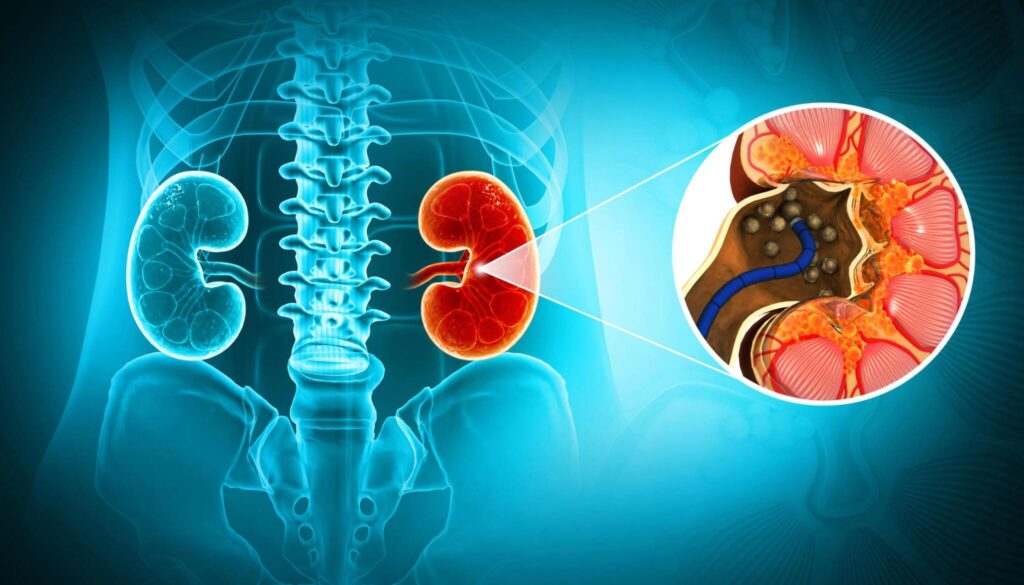Home >> Kidney Stone Surgery
Kidney Stone Surgery in Pune

How do kidney stones form?
- when there is a high level of minerals and stone-forming substances like calcium (hypercalciuria), oxalate (hyperoxaluria), or uric acid (hyperuricosuria) in the urine, which get deposited along the urinary tract, much like silt along a riverbed
- a lack of citrate in the urine, which can wash away these substances
- or insufficient water in the kidneys to dissolve these waste products—a river with less flowing water is dirtier!
What are symptoms of kidney stones?
Stones that lodge in the tube that carries urine from the kidneys to the bladder (ureter) result in severe pain that begins in the loin and lower back and radiates to the groin or front of the lower abdomen. (The pain arises from the muscular tube trying to push the stone out, so is intermittent.) Blood in the urine, visiting the bathroom more times than usual, often having to wake up at night to do so, nausea, and vomiting.
Which tests are used in diagnosis of stones?
- Ultrasound
Ultrasound can detect an enlarged upper urinary tract and kidney caused by a stone lodged in the ureter, but usually cannot detect small stones, especially those located beyond the kidney (in the ureter). It is the preferred imaging method for kidney stone patients who are pregnant.
- Intravenous Pyelogram (IVP)
This test involves taking a series of x-rays after injecting a contrast dye into a vein. Most kidney stones can be precisely located using this procedure.
- Computerized tomography (CT Scan)
It can detect nearly all stones and can be done quickly. CT scan can also help identify other conditions (e.g., ruptured appendix, bowel obstruction) that cause symptoms similar to kidney stones. It can accurately measure the size of the stone, aiding in the choice of treatment.
How are kidney stones treated?
- Treating kidney stone depends on the size, position and number of stones in urinary system, patient age, associated medical conditions (e.g. Aspirin treatment), occupation of the patient, etc.
- The majority of small stones (< 4 mm) that are not causing infection, blockage or symptoms will pass with increased water
- Pain that occurs when small stones start down the ureter can usually be treated with rest and pain killers.
- Certain types of stones, such as those made of uric acid, can be treated with medicines but majority of the stones are composed of calcium and may need a more aggressive level of treatment
- nt.In general, stones larger than 5–6 mm in size need treatment but the decision has to be indivisualized for the patient.
What is Extracorporeal shock wave lithotripsy (ESWL)?
Extracorporeal shock wave lithotripsy uses shock waves to break stones into small pieces without surgery that can be more easily flushed out of the urinary tract and passed out of the body. After identification of the position of the stone with X-ray or ultrasound, shockwaves are applied from outside to fragment the stones.
This procedure takes about 45 minutes to 1 hour and is often done as an outpatient procedure. It can be repeated and may have to be repeated for larger or harder stones. However, it is not suitable for stones larger than 2cm.
What type of surgeries can be used for stone removal?
Open Surgery – Pyelolithotomy/ Ureterolithotomy refers to the open surgical removal of a stone from the kidney/ureter. These techniques are rarely used now a days.
- Ureteroscopy (URS)– Involves the use of an endoscope that can be inserted up the urethra, through the bladder and into the ureter without an incision. Stones are fragmented using Holmium laser.

- Percutaneous surgery (PCNL)– Under anaesthesia a nephroscope is passed through an incision made in the flank area to locate and remove the stone after breaking it(fragmentation)

What is RIRS?( Flexible renal scopy?)
A small flexible scope is passed from urethra into kidney. It is used for small renal stones. It does not require kidney puncture, hence there is no risk of bleeding and can be used in patients in whom PCNL cannot be done. Drawback is it cannot be used in very large stones.
If you are seeking effective Kidney Stone Surgery in Pune, our expert team is here to help. Contact us today to book your consultation and take the first step toward better kidney health.
